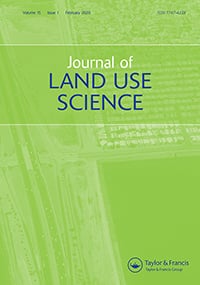Ver ítem
- xmlui.general.dspace_homeCentros e Institutos de InvestigaciónCIAP. Centro de Investigaciones AgropecuariasInstituto de Investigación Animal del Chaco SemiáridoArtículos científicosxmlui.ArtifactBrowser.ItemViewer.trail
- Inicio
- Centros e Institutos de Investigación
- CIAP. Centro de Investigaciones Agropecuarias
- Instituto de Investigación Animal del Chaco Semiárido
- Artículos científicos
- Ver ítem
Understanding the distribution of cattle production systems in the South American Chaco
Resumen
Impacts of cattle production vary among different production systems, but data on their distribution is scarce for most world regions. In this work, we combine datasets on cattle vaccination locations and land cover in a regression framework to define and map major cattle production systems in the Argentinean Dry Chaco. We also explore how cattle occurrence relates to spatial determinants. Results indicate that the region harbors about 5.5 million heads.
[ver mas...]
Impacts of cattle production vary among different production systems, but data on their distribution is scarce for most world regions. In this work, we combine datasets on cattle vaccination locations and land cover in a regression framework to define and map major cattle production systems in the Argentinean Dry Chaco. We also explore how cattle occurrence relates to spatial determinants. Results indicate that the region harbors about 5.5 million heads. Cattle density was mainly described by the share of pasture (69.9%), cropland (28.1%) and aridity (23.8%). We identified 12-major cattle production systems: six cow-calf, three whole-cycle, and three fattening systems. Of these, four systems had high woodland cover (>85%). Data generated is available in a website. Understanding the distribution of cattle production systems is important to assess the environmental impacts of beef production at broad scales. Integrating vaccination data with land-cover information provides a promising avenue to identify livestock systems.
[Cerrar]

Autor
Fernandez, Pedro David;
Kuemmerle, Tobias;
Baumann, Matthias;
Grau, Héctor Ricardo;
Nasca, Jose Andres;
Radrizzani Bonadeo, Alejandro;
Gasparri, Néstor Ignacio;
Fuente
Journal of Land Use Science 15 (1) : 52-68 (2020)
Fecha
2020-02-11
Editorial
Taylor and Francis
ISSN
1747-423X
1747-4248 (online)
1747-4248 (online)
Formato
pdf
Tipo de documento
artículo
Palabras Claves
Derechos de acceso
Restringido
 Excepto donde se diga explicitamente, este item se publica bajo la siguiente descripción: Creative Commons Attribution-NonCommercial-ShareAlike 2.5 Unported (CC BY-NC-SA 2.5)
Excepto donde se diga explicitamente, este item se publica bajo la siguiente descripción: Creative Commons Attribution-NonCommercial-ShareAlike 2.5 Unported (CC BY-NC-SA 2.5)

